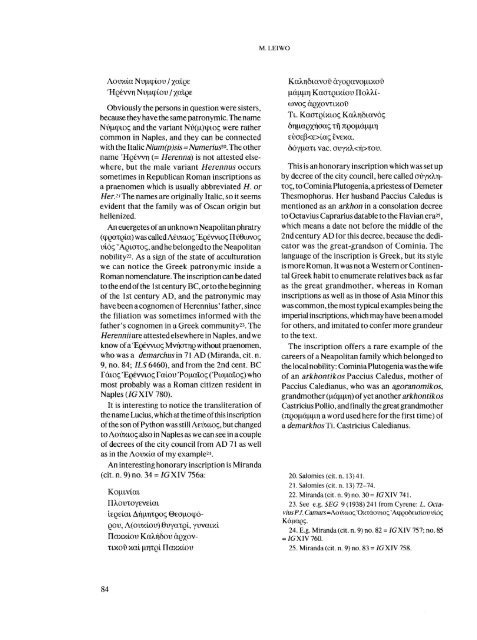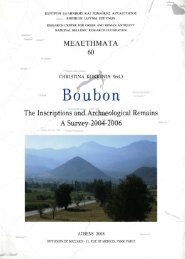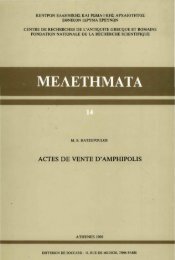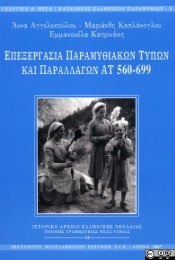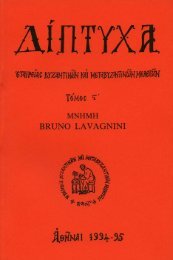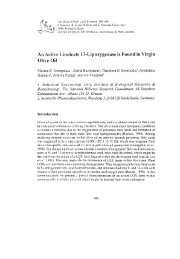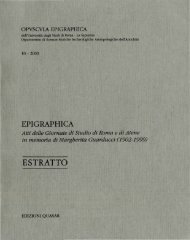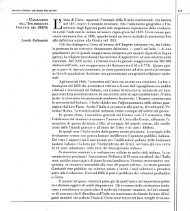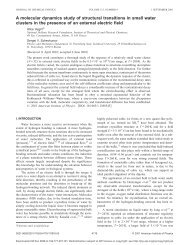Roman onomastics in the Greek East: social and political aspects ...
Roman onomastics in the Greek East: social and political aspects ...
Roman onomastics in the Greek East: social and political aspects ...
Create successful ePaper yourself
Turn your PDF publications into a flip-book with our unique Google optimized e-Paper software.
Λουκία Νυμφίου / χαίρε<br />
Ήρέννη Νυμφίου / χαίρε<br />
Obviously <strong>the</strong> persons <strong>in</strong> question were sisters,<br />
because <strong>the</strong>y have <strong>the</strong> same patronymic. The name<br />
Νύμφιος <strong>and</strong> <strong>the</strong> variant Νύ(μ)ψιος were ra<strong>the</strong>r<br />
common <strong>in</strong> Naples, <strong>and</strong> <strong>the</strong>y can be connected<br />
with <strong>the</strong> Italic Nium(p)sis=Numerius 20 . The o<strong>the</strong>r<br />
name Ήρέννη (= Herenna) is not attested elsewhere,<br />
but <strong>the</strong> male variant Herennus occurs<br />
sometimes <strong>in</strong> Republican <strong>Roman</strong> <strong>in</strong>scriptions as<br />
a praenomen which is usually abbreviated H. or<br />
Her. 2 ' The names are orig<strong>in</strong>ally Italic, so it seems<br />
evident that <strong>the</strong> family was of Oscan orig<strong>in</strong> but<br />
hellenized.<br />
An euergetes of an unknown Neapolitan phratry<br />
(φρατρία) was called Λεύκιος Έρέννιος Πύθωνος<br />
υιός "Αριστος, <strong>and</strong> he belonged to <strong>the</strong> Neapolitan<br />
nobility 22 . As a sign of <strong>the</strong> state of acculturation<br />
we can notice <strong>the</strong> <strong>Greek</strong> patronymic <strong>in</strong>side a<br />
<strong>Roman</strong> nomenclature. The <strong>in</strong>scription can be dated<br />
to <strong>the</strong> end of <strong>the</strong> 1 st century BC, or to <strong>the</strong> beg<strong>in</strong>n<strong>in</strong>g<br />
of <strong>the</strong> 1st century AD, <strong>and</strong> <strong>the</strong> patronymic may<br />
have been a cognomen of Herennius' fa<strong>the</strong>r, s<strong>in</strong>ce<br />
<strong>the</strong> filiation was sometimes <strong>in</strong>formed with <strong>the</strong><br />
fa<strong>the</strong>r's cognomen <strong>in</strong> a <strong>Greek</strong> community 23 . The<br />
Herenniiare attested elsewhere <strong>in</strong> Naples, <strong>and</strong> we<br />
know of a'EQéwioç Μνήστηρ without praenomen,<br />
who was a demarchus <strong>in</strong> 71 AD (Mir<strong>and</strong>a, cit. n.<br />
9, no. 84; ILS 6460), <strong>and</strong> from <strong>the</strong> 2nd cent. BC<br />
Γάιος Έρέννιος Γαίου Τομαιος (Τωμαιος) who<br />
most probably was a <strong>Roman</strong> citizen resident <strong>in</strong><br />
Naples (IG XIV 780).<br />
It is <strong>in</strong>terest<strong>in</strong>g to notice <strong>the</strong> transliteration of<br />
<strong>the</strong> name Lucius, which at <strong>the</strong> time of this <strong>in</strong>scription<br />
of <strong>the</strong> son of Python was still Λεύκιος, but changed<br />
to Λούκιος also <strong>in</strong> Naples as we can see <strong>in</strong> a couple<br />
of decrees of <strong>the</strong> city council from AD 71 as well<br />
as <strong>in</strong> <strong>the</strong> Λουκία of my example 24 .<br />
An <strong>in</strong>terest<strong>in</strong>g honorary <strong>in</strong>scription is Mir<strong>and</strong>a<br />
(cit. n. 9) no. 34 = JGXIV 756a:<br />
84<br />
Κομινίαι<br />
Πλουτογενείαι<br />
ίερείαι Δήμητρος θεσμοφόρου,<br />
Λ(ουκίον) βυγατρί, γυναικι<br />
Πακκίου Καλήδου αρχοντικού<br />
και μητρί Πακκίου<br />
M. LEIWO<br />
Καληδιανοϋ αγορανομικού<br />
μάμμη Καστρικίου Πολλίωνος<br />
αρχοντικού<br />
Τι. Καστρίκιος Καληδιανος<br />
δημαρχήσας τη προμάμμη<br />
εύσεβίας ένεκα.<br />
δόγματι vac. συγκλτου.<br />
This is an honorary <strong>in</strong>scription which was set up<br />
by decree of <strong>the</strong> city council, here called σύγκλητος,<br />
to Com<strong>in</strong>ia Plutogenia, a priestess of Demeter<br />
Thesmophorus. Her husb<strong>and</strong> Paccius Caledus is<br />
mentioned as an arkhon <strong>in</strong> a consolation decree<br />
to Octavius Caprarius datable to <strong>the</strong> Flavian era 25 ,<br />
which means a date not before <strong>the</strong> middle of <strong>the</strong><br />
2nd century AD for this decree, because <strong>the</strong> dedicator<br />
was <strong>the</strong> great-gr<strong>and</strong>son of Com<strong>in</strong>ia. The<br />
language of <strong>the</strong> <strong>in</strong>scription is <strong>Greek</strong>, but its style<br />
is more <strong>Roman</strong>. It was not a Western or Cont<strong>in</strong>ental<br />
<strong>Greek</strong> habit to enumerate relatives back as far<br />
as <strong>the</strong> great gr<strong>and</strong>mo<strong>the</strong>r, whereas <strong>in</strong> <strong>Roman</strong><br />
<strong>in</strong>scriptions as well as <strong>in</strong> those of Asia M<strong>in</strong>or this<br />
was common, <strong>the</strong> most typical examples be<strong>in</strong>g <strong>the</strong><br />
imperial <strong>in</strong>scriptions, which may have been a model<br />
for o<strong>the</strong>rs, <strong>and</strong> imitated to confer more gr<strong>and</strong>eur<br />
to <strong>the</strong> text.<br />
The <strong>in</strong>scription offers a rare example of <strong>the</strong><br />
careers of a Neapolitan family which belonged to<br />
<strong>the</strong> local nobility: Com<strong>in</strong>ia Plutogenia was <strong>the</strong> wife<br />
of an arkhontikos Paccius Caledus, mo<strong>the</strong>r of<br />
Paccius Caledianus, who was an agoranomikos,<br />
gr<strong>and</strong>mo<strong>the</strong>r (μάμμη) of yet ano<strong>the</strong>r arkhontikos<br />
Castricius Pollio, <strong>and</strong> f<strong>in</strong>ally <strong>the</strong> great gr<strong>and</strong>mo<strong>the</strong>r<br />
(προμάμμη a word used here for <strong>the</strong> first time) of<br />
a demarkhosTi. Castricius Caledianus.<br />
20. Salomies (cit. n. 13) 41.<br />
21. Salomies (cit. n. 13) 72-74.<br />
22. Mir<strong>and</strong>a (cit. n. 9) no. 30 = IG XIV 741.<br />
23. See e.g. SEG 9 (1938) 241 from Cyrene: L. OctaviusP.f.<br />
Camars =Λούκιος Όκτάουιος Άφροδεισίουυίος<br />
Κάμαρς.<br />
24. E.g. Mir<strong>and</strong>a (cit. n. 9) no. 82 = JGXIV 757; no. 85<br />
=/G XIV 760.<br />
25. Mir<strong>and</strong>a (cit. n. 9) no. 83 = 7GXIV 758.


